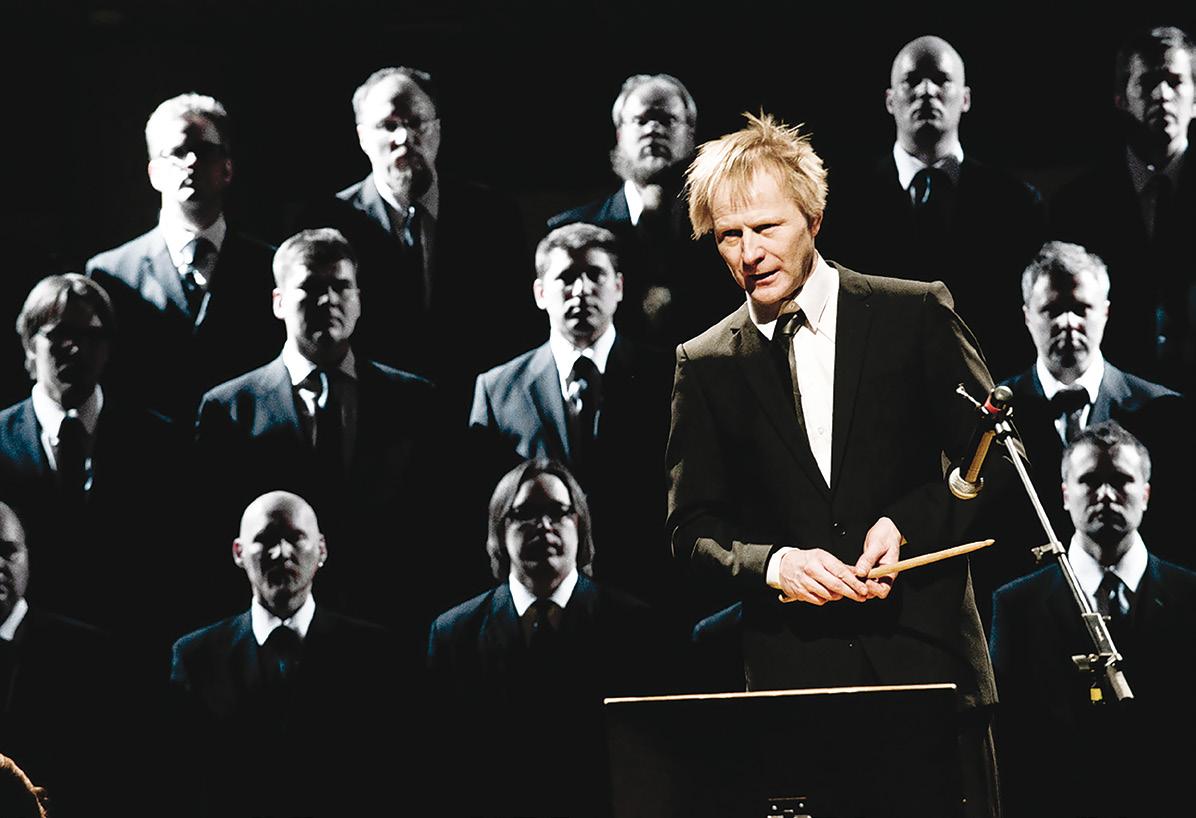
5 minute read
CHORAL TECHNIQUE THE SHOUTING CHOIR OF OULU: MIESKUORO HUUTAJAT
THE SHOUTING CHOIR OF OULU: MIESKUORO HUUTAJAT
INTERVIEW WITH CONDUCTOR PETRI SIRVIÖ
Advertisement
Artikel auf Deutsch Artículo en español Article en français
Mr Sirviö, you founded the Mieskuoro Huutajat (Men’s Shouting Choir) in Oulu, Finland, back in 1987. How did this idea come about?
Generally, I feel that ideas are overrated or their importance in the process is misunderstood; almost everyone gets brilliant and less-brilliant ideas on a regular basis. What is more interesting to me is the path to realising your ideas and to making other people love them. Anyhow, with Huutajat I must confess that the basic concept was mostly my idea, but we developed it in a group of highly spirited friends over about a 6-month period before the first rehearsals. When we got to the rehearsal room, I realised we hadn’t planned any music, so I had to improvise a three-part shouted rendition of the Finnish national anthem – not a good one, but good enough as a proof of concept.
What kind of works do you perform? Is there repertoire already available for screaming choirs?
I have composed all of the repertoire that we perform, except for two or three numbers that we only perform on occasion. There are several composers that have composed for speech choirs, sometimes performed at a loud volume, and of course traditional choirs such as haka choirs in New Zealand, but we have never tried that. When composing, I sometimes have certain rhythm patterns or melodies in mind, but the text is always the starting point for the work. A text to shout can be practically anything: from poems to extracts from laws or treaties, from children’s ditties to songs of mourning. There just has to be something to shout about or something hidden, that a shouted expression reveals.
What type of people are members of your choir? Are they professional or amateur singers, or are they professional screamers? How old are they?
The choir members are amateurs, though some of them are trained musicians. The basic idea for the auditions is that anyone can try. It is rewarding when people with no previously recognised musical skills become excellent shouters with brilliant rhythmic precision and strong vocal expression. In terms of age, we were in our twenties when we started this in 1987 and now we’re 33 years older. New members are often in their 30s or so when they join.
This issue of ICB focusses on “singing and health”. Screaming is not seen as a particularly healthy practice for the voice. How do you warm up and how do you train the voices so they don’t get tired or damaged?
The starting point from which we form the screaming voice is by making a loud voice as naturally as possible, to find the personal register and way of voice production in which it feels easiest to be loud. We don’t have an aesthetic requirement for a beautiful tone of voice, as is the case with most of the art forms of vocal expression. I guess this helps to keep the shouting on the healthy side, with less harmful tension. It might be surprising, but throughout our history no member of the choir has ever had any medical problems with their vocal chords. We warm up as normal choirs do: starting with good deep breathing, relaxed upper body, soft voices at lower registers, drills with simple scales, etc.
Do you perform in concerts or at other events? Can you give some examples?
We have had the privilege to perform at a range of different kinds of venues and set-ups, and I really like it that way. We started with surprise performances in public spaces and have ended up in art museums and doing collaborations with artists from all disciplines — our last major project was with the Royal Ballet of Sweden. But we also do proper two-set concerts and I love them even more: to deliver shouting in a cultivated form for 90 minutes and keep the audience concentrated
and happy all the way it is like a marathon, just as heavy but also just as rewarding.
Do you know of other screaming choirs in Finland or abroad? Have you done any collaborations?
There have been some attempts but I don’t know of any so far that have succeeded.
What is the dream for Mieskuoro Huutajat? And for you?
With limited opportunities to practise and perform, this year has proven that the members just want to go on, and desperately so. Shouting itself and the community of shouters are both fun and rewarding. I share this passion. More generally, I see this whole story as an ongoing centuries-long performance. We started from scratch as an experiment, from a clear concept of a uniformlydressed group of men, both as a picture and a caricature of male society. The musical content grew along this concept, and I, as a composer, want to develop it further and further. But what is maybe even more interesting to me is to follow the sociological process of a team growing and maturing: the founding members were angry young men and some of them are already raging grandfathers; the new members adopt the concept and the spirit but bring some new energy. I don’t just mean the aging of the members, but the process of a society growing together, creating its traditions and manners — for good and for bad — constantly proud of it all, but also with a good pinch of self-deprecation.
Kiitos Paljon
Website and contact info
www.huutajat.org petri@huutajat.org
Edited by Bethany Farr, UK
BE PART OF THE IFCM VOLUNTEER TEAM
The International Federation for Choral Music IFCM is looking for volunteer translators for its quarterly magazine, the International Choral Bulletin (ICB), from
English to French — German to French — Spanish to French
Looking for a good opportunity to gain experience in translation? Send your application to icb.editor@ifcm.net
Knowledge in choral music field is appreciated, but it is neither necessary nor required. Other combinations of these four IFCM official languages are also welcome.

COMPOSER'S CORNER
Japanese Choral Composers and their Works from Songbook:

A Series of Choral Masterpieces published by Japan Choral Association
Akihiro Kanagawa










